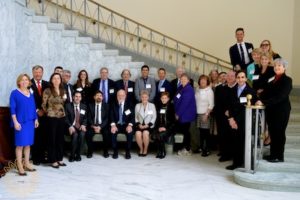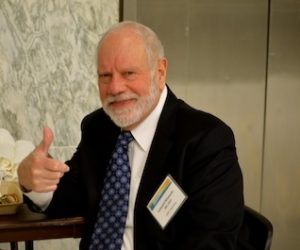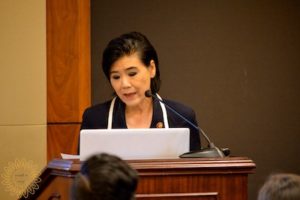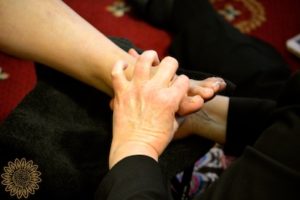Capitol Hill Legislators and Staffers Get a Hands-On Introduction to Integrative Medicine
WASHINGTON DC – On March 6, 2019, the second annual Congressional Integrative Health and Wellness Caucus, co-led by Rep. Judy Chu (D-CA), and Rep. Jackie Walorski (R-IN), was held for an audience of 50 Democratic and Republican House offices, representing 24 states, and eight Senate offices, including the Democratic Leader, Democratic Whip, Assistant Democratic Leader, Senate HELP Committee, and Senate Committee on Homeland Security and Government Affairs.
“The Congressional Briefing and interdisciplinary therapy demonstration were extremely successful with representation form 58 legislative offices from both sides of the aisle. The briefing provided important information regarding effective, non-opioid, integrative approaches to the treatment of pain which will hopefully impact future policy,” said Len Wisneski, IHPC Board of Director’s Chair.
“The response was amazing,” said Kallie Guimond, IHPC’s Director of Government Affairs. “These people are the very same who are going to write legislation for non-pharma options to pain management. Eight Senatorial offices crossed the street to find out more.”
Above all, this year’s caucus itinerary gave participants a true reflection of the heart and soul of integrative medicine. That humanistic touch started with the opening chairs remarks. “The two Co-chairs of the Congressional Caucus broke away from their critical Ways and Means Committee meetings to open the briefing, sharing touching personal stories about why they are committed to advancing non-pharmacological approaches to pain and doing so now,” said Margaret Chesney, PhD, IHPC’s Special Advisor, Professor of Medicine School of Medicine, University of California, San Francisco.
In her remarks, Rep. Walorski shared the following, “I have heard from physicians and providers in my district who are eager to see the nonopioid methods of treating become more integral in patient’s conversations.” She closed by reiterating the horrific story of a death in South Bend, Indiana of a dear friend, Dr. Todd Graham, a local physician who believed in finding creative and alternative ways to address pain. A little more than a year ago, he was shot in his practice driveway from an opioid addict after trying to falsify records to get opioids. Graham’s refusal led to his death. Rep. Walorki said this tragedy is the motivation behind her work to expand the scope of integrative care for chronic pain.
In her opening statement, Rep. Chu held nothing back as she praised the skills of experts in the room and how their respective professions can make a significant difference in the opioid crisis. “The opioid epidemic is taking over lives in every state every day. Right now, deaths from overdoses exceeds those of all other deaths for people under 50,” said Rep. Judy Chu in her opening statement. “The good news is that studies conducted by NIH have concluded that alternative treatments can be effective in treating conditions like chronic pain.” Rep. Chu shared how she has been a long-time advocate of acupuncture. In 2001, when she was elected to the state legislature, Chu worked to get approval for acupuncture to be included in the workman’s compensation system. “I understand well, how important these alternative therapies are. But here in Congress, our biggest challenge is convincing our fellow members that not only do these integrative therapies work, but they should be available to all patients no matter how they get their health coverage,” she said.
The caucus made great headway this year to get that message across. There were multiple opportunities for legislators and staff to learn about integrative medicine. Integrative health experts from academic, government, and association settings held an educational briefing, a lunch featuring anti-inflammatory foods, as well as demonstrations on complementary therapies whereby attendees experienced the benefits of integrative medicine for pain and stress management.
Speakers included members of the military who shared moving and captivating testimonials of how integrative care made a dramatic impact on their health, said Guimond. Other speakers included:
Margaret Chesney, PhD, on an integration to integrative health;
Bob Twillman, PhD, on comprehensive integrative pain management;
Casey Seenauth, ND, on non-pharmacological multi-modality approach to pain;
Susan Luria, on the Connor System;
Ben Kligler MD, on models of care in the Veterans Administration;
Jill Sheppard Davenport, MS, MPP, CNS, NBC-HWC, LDN, LN, on nutrition’s role in pain management.
The integrative therapy room was remarkably successful thanks to teams of therapists and practitioners in acupuncture, chiropractic, massage therapy, and naturopathy, as well as certified reflexologists and craniosacral practitioners. “In a matter of minutes, a meeting room in the Rayburn Building was transformed into a healing environment, said Chesney. “This is a first. We’ve never had so many therapies and disciplines in one room on Capitol Hill. Ninety offices took time out of their day to stop in for 20 minutes for a therapy session. Many came back twice,” said Guimond.
Capitol Hill is known for being a pressure tank. This was not lost on the therapists who immediately saw a difference after a 20-minute treatment. “The feedback that I got from staffers and legislators was how fried they were and how much better they felt with the treatment,” said Amy Mager, vice chair of the American Society of Acupuncturists. “A staffer came in and said she was so grateful we were there because she didn’t have time to get to her acupuncturist. It was a privilege to be of service and watch staffers and legislators slow down. I watched them hold their bodies with more ease during and after the treatment. Providing value and the opportunity for people to reframe what’s going on in their body and come to a place of ease is a privilege.”
A common observation among the therapists was the level of genuine interest by those who came in for a therapy session. “What I found surprising, was that each person I worked with had quite a few questions about reflexology,” said Tish Gilmore, owner of Reflexology by Tish. “I thought people were just being polite, but I was given thoughtful, in depth and inquisitive questions. It was an honor to be there, answering questions and showing them how reflexology works. Within just a few minutes of working on their feet, the participants were truly beginning to relax; shoulders began to drop, breathing became slower and deeper, faces softened. Believe me, the people I worked with were sorely in need of some relaxation!”
At the end of a very productive day, all agreed that the caucus was a great success. “Many asked if we could do this once a month,” said Guimond. “Monthly is ambitious, but it showed that if we are to move the needle forward on interdisciplinary care, examples of integrative medicine need to be hands-on.” The experts, patients and practitioners set a shining example of the potential for integrative care. Now that message needs to translate to legislative change.
In the coming months, IHPC will post each of the speaker’s videos so that you hear from the speakers and can gain a better understanding of this very important day for integrative care.
The Congressional Integrative Health and Wellness Caucus and IHPC would like to thank our title sponsor Life University. Without their support, and the support of those listed below, this event would not have been possible:
Academy of Integrative Health & Medicine
American Academy of Medical Acupuncture
Bastyr University
International Chiropractic Association
Palmer College of Chiropractic
Boiron Homeopathy
+CBD Oil/CV Sciences
Rep. Judy Chu, D-CA., and Rep. Jackie Walorski , R-IN led the Congressional Integrative Health & Wellness Caucus in the 116th Congress. The Caucus serves as a non-partisan educational forum for legislators to receive up-to-date information from experts related to best practices and new research, and to discuss legislative and administrative opportunities for integrative health.
ABOUT IHPC /The Integrative Health Policy Consortium is the national policy and advocacy voice of integrative health and wellness healthcare professional organizations, representing the voice of more than 600,000 healthcare providers. IHPC functions as a critical watchdog and monitor of federal agencies charged with overseeing America’s health and health research needs, working towards eliminating barriers to health. IHPC Chair Dr. Len Wisneski is a Clinical Professor of Medicine at George Washington University Medical Center, Adjunct Faculty at Georgetown University, and is on faculty at The University of Colorado. He has published over 30 scientific articles and a landmark textbook, “The Scientific Basis of Integrative Health.” Website: http://www.ihpc.org.
We use cookies to ensure that we give you the best experience on our website. If you continue to use this site we will assume that you are happy with it.
Integrative Healthcare Goes to Washington with the Congressional Integrative Health and Wellness Caucus
Capitol Hill Legislators and Staffers Get a Hands-On Introduction to Integrative Medicine
WASHINGTON DC – On March 6, 2019, the second annual Congressional Integrative Health and Wellness Caucus, co-led by Rep. Judy Chu (D-CA), and Rep. Jackie Walorski (R-IN), was held for an audience of 50 Democratic and Republican House offices, representing 24 states, and eight Senate offices, including the Democratic Leader, Democratic Whip, Assistant Democratic Leader, Senate HELP Committee, and Senate Committee on Homeland Security and Government Affairs.
Health and Wellness Caucus, co-led by Rep. Judy Chu (D-CA), and Rep. Jackie Walorski (R-IN), was held for an audience of 50 Democratic and Republican House offices, representing 24 states, and eight Senate offices, including the Democratic Leader, Democratic Whip, Assistant Democratic Leader, Senate HELP Committee, and Senate Committee on Homeland Security and Government Affairs.
“The Congressional Briefing and interdisciplinary therapy demonstration were extremely successful with representation form 58 legislative offices from both sides of the aisle. The briefing provided important information regarding effective, non-opioid, integrative approaches to the treatment of pain which will hopefully impact future policy,” said Len Wisneski, IHPC Board of Director’s Chair.
successful with representation form 58 legislative offices from both sides of the aisle. The briefing provided important information regarding effective, non-opioid, integrative approaches to the treatment of pain which will hopefully impact future policy,” said Len Wisneski, IHPC Board of Director’s Chair.
“The response was amazing,” said Kallie Guimond, IHPC’s Director of Government Affairs. “These people are the very same who are going to write legislation for non-pharma options to pain management. Eight Senatorial offices crossed the street to find out more.”
In her opening statement, Rep. Chu held nothing back as she praised the skills of experts in the room and how their respective professions can make a significant difference in the opioid crisis. “The opioid epidemic is taking over lives in every state every day. Right now, deaths from overdoses exceeds those of all other deaths for people under 50,” said Rep. Judy Chu in her opening statement. “The good news is that studies conducted by NIH have concluded that alternative treatments can be effective in treating conditions like chronic pain.” Rep. Chu shared how she has been a long-time advocate of acupuncture. In 2001, when she was elected to the state legislature, Chu worked to get approval for acupuncture to be included in the workman’s compensation system. “I understand well, how important these alternative therapies are. But here in Congress, our biggest challenge is convincing our fellow members that not only do these integrative therapies work, but they should be available to all patients no matter how they get their health coverage,” she said.
in the room and how their respective professions can make a significant difference in the opioid crisis. “The opioid epidemic is taking over lives in every state every day. Right now, deaths from overdoses exceeds those of all other deaths for people under 50,” said Rep. Judy Chu in her opening statement. “The good news is that studies conducted by NIH have concluded that alternative treatments can be effective in treating conditions like chronic pain.” Rep. Chu shared how she has been a long-time advocate of acupuncture. In 2001, when she was elected to the state legislature, Chu worked to get approval for acupuncture to be included in the workman’s compensation system. “I understand well, how important these alternative therapies are. But here in Congress, our biggest challenge is convincing our fellow members that not only do these integrative therapies work, but they should be available to all patients no matter how they get their health coverage,” she said.
The caucus made great headway this year to get that message across. There were multiple opportunities for legislators and staff to learn about integrative medicine. Integrative health experts from academic, government, and association settings held an educational briefing, a lunch featuring anti-inflammatory foods, as well as demonstrations on complementary therapies whereby attendees experienced the benefits of integrative medicine for pain and stress management.
Speakers included members of the military who shared moving and captivating testimonials of how integrative care made a dramatic impact on their health, said Guimond. Other speakers included:
The integrative therapy room was remarkably successful thanks to teams of therapists and practitioners in acupuncture, chiropractic, massage therapy, and naturopathy, as well as certified reflexologists and craniosacral practitioners. “In a matter of minutes, a meeting room in the Rayburn Building was transformed into a healing environment, said Chesney. “This is a first. We’ve never had so many therapies and disciplines in one room on Capitol Hill. Ninety offices took time out of their day to stop in for 20 minutes for a therapy session. Many came back twice,” said Guimond.
practitioners in acupuncture, chiropractic, massage therapy, and naturopathy, as well as certified reflexologists and craniosacral practitioners. “In a matter of minutes, a meeting room in the Rayburn Building was transformed into a healing environment, said Chesney. “This is a first. We’ve never had so many therapies and disciplines in one room on Capitol Hill. Ninety offices took time out of their day to stop in for 20 minutes for a therapy session. Many came back twice,” said Guimond.
Capitol Hill is known for being a pressure tank. This was not lost on the therapists who immediately saw a difference after a 20-minute treatment. “The feedback that I got from staffers and legislators was how fried they were and how much better they felt with the treatment,” said Amy Mager, vice chair of the American Society of Acupuncturists. “A staffer came in and said she was so grateful we were there because she didn’t have time to get to her acupuncturist. It was a privilege to be of service and watch staffers and legislators slow down. I watched them hold their bodies with more ease during and after the treatment. Providing value and the opportunity for people to reframe what’s going on in their body and come to a place of ease is a privilege.”
immediately saw a difference after a 20-minute treatment. “The feedback that I got from staffers and legislators was how fried they were and how much better they felt with the treatment,” said Amy Mager, vice chair of the American Society of Acupuncturists. “A staffer came in and said she was so grateful we were there because she didn’t have time to get to her acupuncturist. It was a privilege to be of service and watch staffers and legislators slow down. I watched them hold their bodies with more ease during and after the treatment. Providing value and the opportunity for people to reframe what’s going on in their body and come to a place of ease is a privilege.”
A common observation among the therapists was the level of genuine interest by those who came in for a therapy session. “What I found surprising, was that each person I worked with had quite a few questions about reflexology,” said Tish Gilmore, owner of Reflexology by Tish. “I thought people were just being polite, but I was given thoughtful, in depth and inquisitive questions. It was an honor to be there, answering questions and showing them how reflexology works. Within just a few minutes of working on their feet, the participants were truly beginning to relax; shoulders began to drop, breathing became slower and deeper, faces softened. Believe me, the people I worked with were sorely in need of some relaxation!”
worked with had quite a few questions about reflexology,” said Tish Gilmore, owner of Reflexology by Tish. “I thought people were just being polite, but I was given thoughtful, in depth and inquisitive questions. It was an honor to be there, answering questions and showing them how reflexology works. Within just a few minutes of working on their feet, the participants were truly beginning to relax; shoulders began to drop, breathing became slower and deeper, faces softened. Believe me, the people I worked with were sorely in need of some relaxation!”
In the coming months, IHPC will post each of the speaker’s videos so that you hear from the speakers and can gain a better understanding of this very important day for integrative care.
The Congressional Integrative Health and Wellness Caucus and IHPC would like to thank our title sponsor Life University. Without their support, and the support of those listed below, this event would not have been possible:
Rep. Judy Chu, D-CA., and Rep. Jackie Walorski , R-IN led the Congressional Integrative Health & Wellness Caucus in the 116th Congress. The Caucus serves as a non-partisan educational forum for legislators to receive up-to-date information from experts related to best practices and new research, and to discuss legislative and administrative opportunities for integrative health.
ABOUT IHPC /The Integrative Health Policy Consortium is the national policy and advocacy voice of integrative health and wellness healthcare professional organizations, representing the voice of more than 600,000 healthcare providers. IHPC functions as a critical watchdog and monitor of federal agencies charged with overseeing America’s health and health research needs, working towards eliminating barriers to health. IHPC Chair Dr. Len Wisneski is a Clinical Professor of Medicine at George Washington University Medical Center, Adjunct Faculty at Georgetown University, and is on faculty at The University of Colorado. He has published over 30 scientific articles and a landmark textbook, “The Scientific Basis of Integrative Health.” Website: http://www.ihpc.org.
Related Articles
Immune Resilience: A Science-Backed Protocol for Preventive Maintenance
Read MoreImmune Boot Camp: Immune Support for Back to School and Beyond
Read MoreSunlight as a Non-Invasive Modulator of Ocular and Systemic Mitochondrial Function
Read More